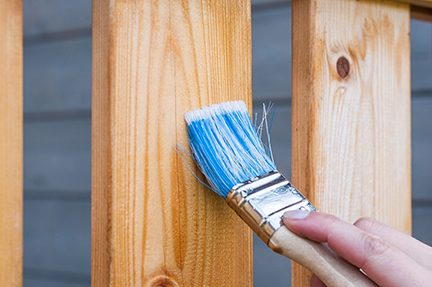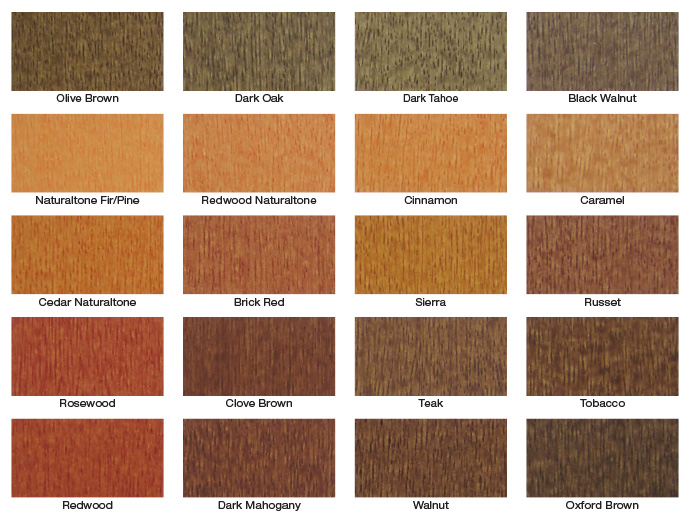Stains, varnishes, and lacquers are liquids used to beautify and enhance wooden surfaces. They do have a significant amount of differences which we’ll touch on here.
Stain adds a tint to the wood. It brings out the appearance of the wood grain itself. The other types don’t necessarily add any colour.

Both varnishes (and lacquers) add a hard, almost plastic-like, protective finish. Their properties are also quite different.
Varnishes create a waterproof barrier on the outside of wooden surfaces. It sits on top and doesn’t soak into the wood. It establishes a glassy layer of protection, similar to plastic protecting wood from moisture.
Varnishes are often used on window frames, doors, flooring, wooden walls, and more. It can be applied to projects inside or outside the home.
Like stains, deck varnishes can also be tinted. Tinted varnish is most effective on wood that already has a natural appearance. As an example, a cherry varnish is most effective on wood that has a dark red tint. Even clear varnish has the potential to shade. Lighter-coloured wood turns more golden, and dark wood becomes even darker.
Wood Stain Points

• Make the patterns in the wood grain stand out more showing off their natural beauty.
• Used to add tint to wood and can make one type of light wood look more like another that has more colour to it.
• Contain a pigment mixed with water, linseed oil, or even a gel.
• Water-based dry fast and only require water for cleanup. They don’t, however, penetrate as deeply as oil- or gel-based stains.
• They’re more likely to leave brush strokes or rag marks.
• Oil-based stains cover well since they take longer to dry, but they also require mineral spirits for cleanup.
• Gel-based are the thickest of the three. Apply with a rag, rubbing it in to achieve the desired tint.
• Mineral spirits are the best way to clean up messes after working with a gel stain.
• Stain usually requires a protective coating, such as varnish or lacquer, if you want more longevity in the wood and colour.
• There are hybrid products that have stains and/or tints mixed into what would usually be just a protective clear sealer.
Wood Stain Application Tips
- Apply the stain in the direction of the grain.
- Reapply every three to five years.
- If water is beading up on the surface of the wood, then the stain is still good. If the water soaks into the wood, then the stain needs to be replaced.
VARNISH POINTS
• Varnish is a usually a clear coating applied over stained or untreated wood.
• Varnish offers a durable, shiny finish that also provides some protection from ultraviolet rays and the elements.
• A good coating of varnish also protects wood from everyday issues, such as scratches and dents.
• Varnish usually ranges from a semigloss to a satin finish.
Varnish Application Tips
- Bend the paintbrush as few times as possible when applying varnish. Don’t press hard on the wood.
- Apply thin coats of varnish to prevent bubbling and undesirable textures.
- Act fast when applying varnishes to the wood. Water-based varnishes dry quicker than oil-based.
LACQUER POINTS
• Like varnish, lacquer provides a protective clear shell over bare or previously stained wood.
• Lacquer is a mixture of shellac in alcohol and sometimes other additives. It goes on thinner than varnish. It’s quite glossy but also comes in a variety of sheens similar to paint.
• Lacquer dries faster and is usually applied by a spray and requires lacquer thinner for cleanup.
• Lacquer is quite thin but durable, resists water damage and generally won’t discolor over time.
SO, VARNISH, LACQUER OR STAIN?
Some surfaces are more appropriate for stain, while others are better suited for varnishes.
While a varnish is a protective layer on the outside of wood, a stain will deeply penetrate the wood, changing or enhancing its natural colour. Although stains don’t provide as much protection as a varnish, you can varnish after the stain is applied giving it increased durability and longer lasting colour.
Thanks for reading this months blog. Join us again next month for more useful info, tips and tricks to help beautify your home!



